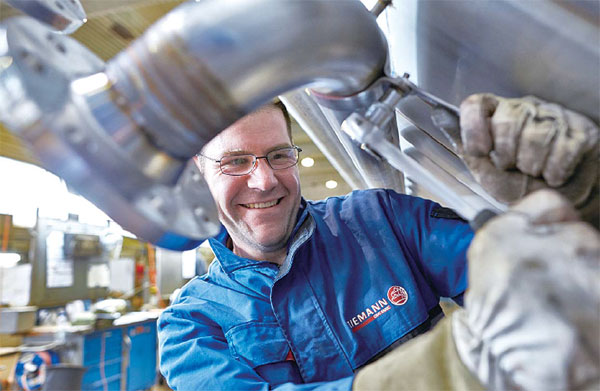Growth is brewing in specialty equipment

Mergers and acquisitions are key to company's strategy along Belt and Road as it anticipates a twist for new tastes
China's specialty equipment maker CIMC ENRIC Holding will continue to pursue mergers and acquisitions in developed countries as part of its expansion into markets along the Belt and Road Initiative.
The energy, chemical and liquid-food equipment company is a major subsidiary of China International Marine Containers (Group), the country's largest transportation equipment producer by revenue.
In June, the subsidiary bought out the United Kingdom-based Briggs Group, another food equipment provider, for 23 million ($28.6 million; 25.8 million euros).
| A Ziemann worker adjusts equipment at a brewery project in Mexico. Provided to China Daily |
CIMC ENRIC's technologies are expected to double Briggs' revenues and profits over the next five years. It is the third food equipment business that CIMC ENRIC has acquired in Europe. The previous two pickings have seen substantial localization of their operations, which benefited their domestic markets, the company says.
Yu Jiamin, CIMC ENRIC's director for strategic development, says the industry worldwide has been upgrading.
The "Make in India" campaign is also expected to shake up the global manufacturing sector.
"Chinese enterprises need to absorb excellent resources from global brands through overseas M&A, and build core strengths in branding, technology and talent, rather than low-end manufacturing," Yu says, adding that they need to upgrade their technologies faster and localize global operations.
The trade, services and infrastructure network proposed by the Chinese government in 2013 envisions a Silk Road Economic Belt and a 21st Century Maritime Silk Road, covering about 4.4 billion people in more than 60 countries and regions in Europe, Asia and Africa.
Countries along the Belt and Road Initiative, including Vietnam, South Korea, Mongolia, Nigeria, Angola, Ethiopia and Russia, are key to CIMC ENRIC as it increases its investment in marketing and resource integration over the next five years.
"We don't simply ship products or introduce technology. We acquire global advanced resources like management expertise, technology, talent and brands through M&A, to make the company efficient and effective in globalizing our business," Yu says.
Ding Lixin, a researcher at the Chinese Academy of Agricultural Sciences in Beijing, says it is reasonable for domestic beer and beverage equipment suppliers to seek new opportunities in emerging markets for sustainable growth. For example, markets in the ASEAN region, Brazil and Nigeria are not affected by cold weather conditions because of their geographic locations.
The Briggs deal will likely provide CIMC ENRIC with effective resources such as distilling and yeast for non-brewing industries, and boost efforts to build capability in the non-brewing equipment sector, he says.
CIMC ENRIC's sales revenue was 8.24 billion yuan ($1.2 billion; 1.1 billion euros; 980 million) in 2015, with 26 percent of it coming from its liquid food equipment business.
So the Briggs deal is key, and will give the company about a 30 percent market share globally for brewing equipment, making it one of the world's three biggest suppliers, Ding says.
"The growing demand for beer and beverage products in countries along the Belt and Road Initiative will bring more choices to consumers - to choose local beer or drink a variety of brands, as they have better and more options to pick products that they think are cheaper, safer and better in taste, instead of only selecting beer products from developed markets."
Eager to enhance its earnings from the domestic market, the company began operations in September at its new breweries. It installed a mash filter, brewhouse, cold area and a big tank sourced from a top brewer in Baoding, Hebei province.
The company also invested in another brewery project in Jishui, Jiangxi province, Phase I of which began operations recently.
The two projects entailed investments of 2 billion yuan and 1.6 billion yuan. They are expected together to yield 1 million metric tons of beer and 2 billion yuan in sales annually upon full completion by Ziemann Holvrieka Asia Co.
The latter is the Asian production base of Ziemann and Holvrieka, which specialize in engineering, procurement and construction, or EPC projects, a common form of contracting in recent years.
Ziemann and Holvrieka are two brands in the liquid food equipment industry acquired by CIMC ENRIC - from Germany, the Netherlands, Belgium and Denmark in 2012 and 2009.
Ziemann and Holvrieka so far have delivered more than 120 brewing EPC projects in 33 countries and regions, including Mongolia, Singapore and Papua New Guinea. They have seven research and development centers in Asia and Europe and plan to build more marketing networks in countries along the Belt and Road Initiative.
"The most obvious opportunity is the modernization of beverage and food supply chains," says Lars Roed, general manager of Ziemann Holvrieka Asia. "That is a big area and there are lots of investments going on there."
Roed says demand for beer, milk, yogurt, juice and soft drinks will also offer new growth points for both equipment and ingredient businesses.
"We have seen lots of potential in this sector, not only in China, but in many dynamic emerging economies," he says.
zhongnan@chinadaily.com.cn
(China Daily European Weekly 11/11/2016 page28)
Today's Top News
- Xi calls for promoting volunteer spirit to serve national rejuvenation
- Xi chairs CPC meeting to review report on central discipline inspection
- Reunification will only make Taiwan better
- Outline of Xi's thought on strengthening military published
- Targeted action plan to unleash consumption momentum
- Separatist plans of Lai slammed































